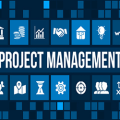
Many people become project managers simply by receiving additional responsibility or via promotion into the role. As such, project management fundamentals are often unknown to the very people who manage projects. To make matters worse, the Project Management Institute’s Project Management Body of Knowledge (PMBOK) is a very structured, analytical outline of a somewhat abstract topic. Although the relevant information is there, it is difficult to put into practice without external training.
To that end, I have compiled the following overview which I hope will take the PMBOK structure and make it real.
Let’s get started. Projects are neatly divided into five phases:
- Initiating
- Planning
- Execution
- Controlling
- Closing
Initiating
To create the project, the project manager and/or project sponsor develops a project charter, which defines the organization’s vision for the project and the business case for it. It defines why the project is being undertaken and what problem it is meant to solve. It lays out the funding status and expectations of the organization. Most projects have primary stakeholders who are foundational to the project, and these could be identified and their concerns addressed.
In essence, it’s what the organization is thinking when creating the project.
Planning
The planning phase is the largest of the five from the perspective of project management fundamentals. In fact, all ten of the project management “knowledge areas” are addressed when planning the project.
During this phase a document called a “Project Management Plan” (or similar name) is drawn up. This document serves as the project plan and lays out how the project will be managed, executed, and controlled.
The project management plan should contain anything that is necessary to ensure the project completes successfully with all of its stakeholders satisfied. That said, there are fundamental guidelines for the type of information that is contained within it.
The mandatory information is:
- Scope statement. This item defines the boundaries of the project. Although a project charter contains a basic scope statement designed to define the organization’s vision for the project, the project management plan should expand on it to define the the precise boundaries from the project manager’s perspective. You can’t define everything, but the scope statement should contain enough detail to minimize risk of scope changes or scope creep during project execution.
- Work Breakdown Structure. This is a list of activities included in the project. It can be in graphical or table form. For more information, take a look at our blog post on work breakdown structures.
- Project Schedule. Since projects, by definition, have a finite start and end date, a project schedule communicates the milestone and final completion dates. As a minimum, for small projects a completion date can be communicated to the project sponsor. The schedule provides a baseline for creating schedule control mechanisms to ensure delivery dates are met. It can be in graphical or table form, as long is it shows the start and end dates of each task in the work breakdown structure.
- Project Budget. Again, since projects have a finite start and end date, they must have a finite budget. Each task in the work breakdown structure must have a cost associated with it, which in turn is rolled up into the overall project budget.
For small projects that take less than about 100 man-hours to complete, this can be satisfactory. The larger the project, however, the more of the following information is warranted:
- Critical Success Factors. These represent the definition of project success or failure. Most projects have a primary success factor, like whether the bridge gets built without failing or the website design is satisfactory to the client. But there are usually many secondary success factors like whether the project was under budget, ahead of schedule, adjacent landowners were satisfied, etc.
- Quality Management Plan. This defines what the minimum level of quality is, how it will be obtained, and how to measure it. Almost every industry contains written quality standards which can be used as quality targets. ISO 9001 serves as a quality certification for the organization. In the construction industry, the American Society for Testing and Materials (ASTM) contains many quality standards for individual products. In the electronics fields, Institute for Electrical and Electronics Engineering (IEEE) maintains product standards.
- Risk Management Plan. This plan identifies the primary risks to the project, prioritizes them, and creates response plans for those risks that are considered substantial enough to warrant them.
- Human Resource Management Plan. This plan identifies the people requirements to complete the project, as well as how they will be obtained and managed.
- Communications Management Plan. This plan identifies the communication requirements of the project. Although communication must always happen on an informal level, most projects have standard communications requirements that can be put into a written plan (think: progress updates, investor circulars, client meetings). This plan identifies who needs what information, when they need it, and the format and storage location.
- Procurement Management Plan. This plan identifies the external purchasing needs of the project: What to acquire, how to acquire it, how much is needed, and when to acquire it. It includes the types of contracts that will be used, prequalification processes, and tender procedures.
Executing
Naturally, project management fundamentals cannot address the technical details of every project in every industry. But there are several project fundamentals that apply to this phase, and the project manager must choose the applicable ones for their project.
- Perform Quality Assurance. The project manager or project management team must audit and inspect the processes to ensure that the quality standards identified during the planning phase is achieved.
- Manage Project Team. The project team that is identified during the planning stage is acquired and managed. Training and development of the project team is put into practice as necessary to obtain the knowledge to complete the project.
- Manage Communications. All of the important project communication, such as e-mail, letters, memos, updates, press releases, etc. are filed in a central, easily accessible place.
- Conduct Procurements. Terms of Reference (aka Statements of Work) are prepared, sellers are selected and contracts are awarded. Negotiations can play a major role and thus represent a necessary core competency of the project team.
- Manage Stakeholder Engagements. The stakeholders’ expectations are actively managed to ensure they are satisfied with the results produced by the project.
Controlling
During the project it is imperative that controls be utilized so that the project stays on track, particularly as it relates to schedule and cost. Although this phase occurs concurrent to the execution phase, project management fundamentals include the following items during this phase.
- Control Schedule. To ensure the project completion date is met, the project management team performs earned value analysis and calculates schedule variance.
- Control Costs. The ensure the project completes under budget, the project management team tracks project costs and calculates cost variance.
- Perform Quality Control. Unlike quality assurance (during the execution phase, above), quality control is focused on the identification of quality problems. Inspections and statistics seek to identify the quality level of the outputs of the project.
- Validate Scope. Once deliverables are submitted to the project sponsor or other stakeholders, they must formally approve them to release the project of further obligations relating to those deliverables.
- Control Communications. The project manager must ensure that the right message is communicated to the right audience at the right time.
- Control Procurements. The project manager establishes controls on the quality of work produced by vendors, authorizes work packages as required, and manages risks arising from the work being performed by vendors (or the relationship itself).
If any of the above project controls identifies the need for changes to the project (schedule, budget, etc.) the project manager must make the necessary changes to the project management plan and obtain the necessary approvals as identified in the project management plan.
Closing
During the closing phase, the following things take place:
- All project documentation is formally closed. As-built conditions and final details are certified.
- External consultants, contractors, and suppliers are released of their obligations. Long term liabilities are formalized.
- Commissioning of new infrastructure
- Communication is made to the relevant parties that the project is complete.
I hope that this overview has given you some ideas to help you put the PMBOK into practice. Let us all know what fundamentals you use and how you can improve project management in the comments section below.











Leave a Reply